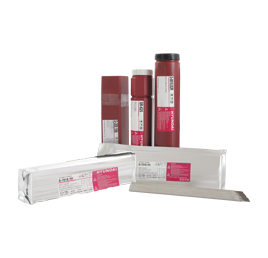ALL PRODUCT




.jpg)



















Stick Electrodes
S-10018.D2

- Caution .
- Purpose ① Carbon-Manganese and Chromium-Molybdenum steel Pipng (AISI 4130, 4140
-
Attribute
① Low hydrogen electrode
② Welding 690MPa class Low alloy steel

S-78LTH

- Caution .
-
Purpose
① Low temperature strength steel
② Offshore structure
③ LPG, LNG storage tank -
Attribute
① Low-Hydrogen electrode
② Iron powder and low hydrogen type electrode (high efficiency)
③ Good impact value at -60°C
④ Vacuum sealed packge available (HDM ≤ 5ml/100g)

S-86LTH
.jpg)
-
Caution
① Dry the electrodes at 350~400 ℃(662~752℉) for 60 minutes before use.
② Preheat at 100~150℃(212~302℉). The temperature varies in accordance with plate thickness and kind of steel.
③ Adopt back step method or strike the arc on a small steel plate prepared for this particular purpose because arc striking on the base metal is in danger of initiating cracking.
④ Pay attention not to exceed proper heat-input because excessive heat-input causes deterioration of impact values of all weld metal. -
Purpose
① OffShore Structure
② LPG vessel
③ LPG storage
④ Heat Exchanger -
Attribute
① 55kg grade low-hydrogen high tensile electrode (-60°C)
② Ni, Ti, B contained in the weld-metal.
③ Great tensile strength in low-temperature
④ Anti- Low temperature crack (Low hydrogen)

S-8018.C3

-
Caution
① Dry the electrodes at 350~400℃(662~752℉) for 60 minutes before use.
② Adopt back step method or strike the arc on a small steel plate prepared for this particular purpose, because arc striking on the base metal is in danger of initiating cracking.
③ Preheat at 80~100℃(176~212℉) before use. The temperature to be applied varies in accordance with plate thickness and steel kind. - Purpose ① Low temperature strength steel (1% Ni) • Offshore structure
-
Attribute
① Good impact value at -40°C
② Iron powder and low hydrogen type electrode (high efficiency

S-8018.C1

-
Caution
① Dry the electrodes at 350~400 ℃(662~752℉) for 60 minutes before use.
② Preheat at 80~100℃(176~212℉).
③ Keep the arc as short as possible. -
Purpose
① Low temperature strength steel (2.5% Ni)
② Offshore structure -
Attribute
① Good impact value at -60°C
② Iron powder and low hydrogen type electrode (high efficiency

S-8016.C3

-
Caution
① Dry the electrodes at 350~400℃(662~752℉) for 60 minutes before use.
② Adopt back step method or strike the arc on a small steel plate prepared for this particular purpose to prevent blowhole at the arc starting.
③ Pay attention not to exceed proper heat-input because excessive heat-input causes deterioration of impact values of all weld metal. -
Purpose
① Low temperature strength steel (1% Ni)
② Offshore structure - Attribute ① Good impact value at -40°C

S-8016.C2

-
Caution
① Dry the electrodes at 350~400 ℃(662~752℉) for 60 minutes before use.
② Preheat at 100~150℃(212~302℉). Preheat temperature varies in accordance with the plate thickness and steel kind.
③ Keep the arc as short as possible. -
Purpose
① Low temperature strength steel (3.5% Ni)
② Offshore structure - Attribute ① Good impact value at -60~-75°C

S-8016.C1

-
Caution
① Dry the electrodes at 350~400 ℃(662~752℉) for 60 minutes before use.
② Adopt back step method or strike the arc on a small steel plate prepared for this particular purpose because arc striking on the base metal is prone to initiating cracking.
③ Keep the arc as short as possible.
④ Preheat at 80~100℃(176~212℉). The temperature varies in accordance with the plate thickness and possible.
⑤ If each welded pass becomes thicker than acceptable level by high amperage or low speed ratio manipulation, the impact values and yield points will decrease." -
Purpose
① Low temperature strength steel (2.5% Ni)
② Offshore structure - Attribute ① Good impact value at -60°C

S-7016.LS

- Caution .
-
Purpose
① Low temperature strength steel
② Offshore structure
③ LPG, LNG storage tank -
Attribute
① Extra low hydrogen electrode
② Good impact value at -60°C
③ CTOD properties at -10°C (14°F) temperature

S-76LTH

- Caution .
-
Purpose
① Low temperature strength steel
② Offshore structure
③ LPG, LNG storage tank -
Attribute
① Low temperature strength steel
② Offshore structure
③ LPG, LNG storage tank

S-7018.1H

- Caution .
-
Purpose
① Heavy steel fabrication
② Low temperature strength steel
③ Offshore structure -
Attribute
① Extra low hydrogen electrode
② Good impact value at -45°C
③ Vacuum sealed package available (HDM ≤ 4ml/100g)

S-7018.1

-
Caution
① Dry the electrodes at 350~400℃(622~752℉) for 60 minutes before use.
② Keep the arc as short as possible, and avoid large width of weaving.
③ Adopt back step method or strike the arc on a small steel plate prepared for this particular purpose to prevent blow hole at the arc starting. -
Purpose
① Heavy steel fabrication
② Low temperature strength steel
③ Offshore structure -
Attribute
① Suitable for butt and fillet welding of thin and medium-thick plates (up to 20mm)
② Iron powder and low hydrogen type electrode (high efficiency)
③ Good impact value at -45°C
